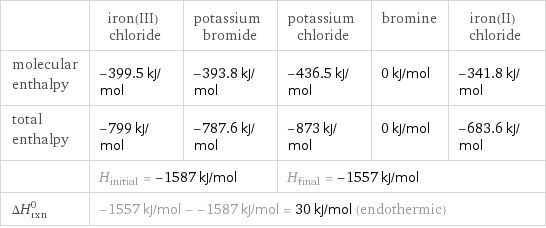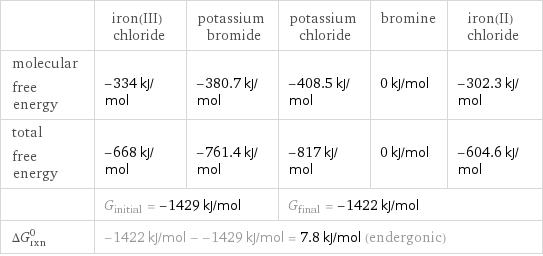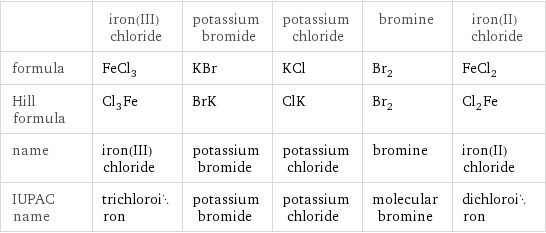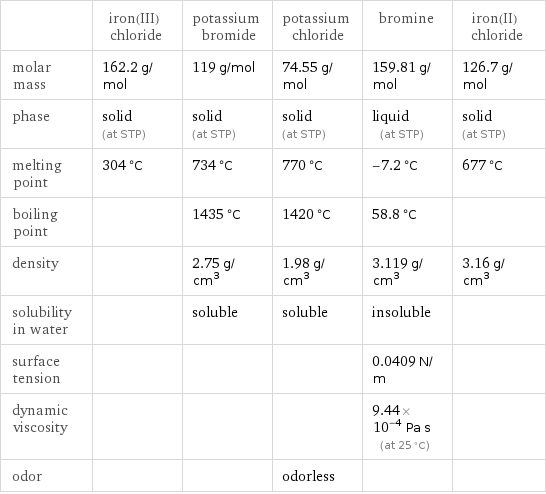Input interpretation

FeCl_3 iron(III) chloride + KBr potassium bromide ⟶ KCl potassium chloride + Br_2 bromine + FeCl_2 iron(II) chloride
Balanced equation

Balance the chemical equation algebraically: FeCl_3 + KBr ⟶ KCl + Br_2 + FeCl_2 Add stoichiometric coefficients, c_i, to the reactants and products: c_1 FeCl_3 + c_2 KBr ⟶ c_3 KCl + c_4 Br_2 + c_5 FeCl_2 Set the number of atoms in the reactants equal to the number of atoms in the products for Cl, Fe, Br and K: Cl: | 3 c_1 = c_3 + 2 c_5 Fe: | c_1 = c_5 Br: | c_2 = 2 c_4 K: | c_2 = c_3 Since the coefficients are relative quantities and underdetermined, choose a coefficient to set arbitrarily. To keep the coefficients small, the arbitrary value is ordinarily one. For instance, set c_4 = 1 and solve the system of equations for the remaining coefficients: c_1 = 2 c_2 = 2 c_3 = 2 c_4 = 1 c_5 = 2 Substitute the coefficients into the chemical reaction to obtain the balanced equation: Answer: | | 2 FeCl_3 + 2 KBr ⟶ 2 KCl + Br_2 + 2 FeCl_2
Structures

+ ⟶ + +
Names

iron(III) chloride + potassium bromide ⟶ potassium chloride + bromine + iron(II) chloride
Reaction thermodynamics
Enthalpy

| iron(III) chloride | potassium bromide | potassium chloride | bromine | iron(II) chloride molecular enthalpy | -399.5 kJ/mol | -393.8 kJ/mol | -436.5 kJ/mol | 0 kJ/mol | -341.8 kJ/mol total enthalpy | -799 kJ/mol | -787.6 kJ/mol | -873 kJ/mol | 0 kJ/mol | -683.6 kJ/mol | H_initial = -1587 kJ/mol | | H_final = -1557 kJ/mol | | ΔH_rxn^0 | -1557 kJ/mol - -1587 kJ/mol = 30 kJ/mol (endothermic) | | | |
Gibbs free energy

| iron(III) chloride | potassium bromide | potassium chloride | bromine | iron(II) chloride molecular free energy | -334 kJ/mol | -380.7 kJ/mol | -408.5 kJ/mol | 0 kJ/mol | -302.3 kJ/mol total free energy | -668 kJ/mol | -761.4 kJ/mol | -817 kJ/mol | 0 kJ/mol | -604.6 kJ/mol | G_initial = -1429 kJ/mol | | G_final = -1422 kJ/mol | | ΔG_rxn^0 | -1422 kJ/mol - -1429 kJ/mol = 7.8 kJ/mol (endergonic) | | | |
Equilibrium constant
![Construct the equilibrium constant, K, expression for: FeCl_3 + KBr ⟶ KCl + Br_2 + FeCl_2 Plan: • Balance the chemical equation. • Determine the stoichiometric numbers. • Assemble the activity expression for each chemical species. • Use the activity expressions to build the equilibrium constant expression. Write the balanced chemical equation: 2 FeCl_3 + 2 KBr ⟶ 2 KCl + Br_2 + 2 FeCl_2 Assign stoichiometric numbers, ν_i, using the stoichiometric coefficients, c_i, from the balanced chemical equation in the following manner: ν_i = -c_i for reactants and ν_i = c_i for products: chemical species | c_i | ν_i FeCl_3 | 2 | -2 KBr | 2 | -2 KCl | 2 | 2 Br_2 | 1 | 1 FeCl_2 | 2 | 2 Assemble the activity expressions accounting for the state of matter and ν_i: chemical species | c_i | ν_i | activity expression FeCl_3 | 2 | -2 | ([FeCl3])^(-2) KBr | 2 | -2 | ([KBr])^(-2) KCl | 2 | 2 | ([KCl])^2 Br_2 | 1 | 1 | [Br2] FeCl_2 | 2 | 2 | ([FeCl2])^2 The equilibrium constant symbol in the concentration basis is: K_c Mulitply the activity expressions to arrive at the K_c expression: Answer: | | K_c = ([FeCl3])^(-2) ([KBr])^(-2) ([KCl])^2 [Br2] ([FeCl2])^2 = (([KCl])^2 [Br2] ([FeCl2])^2)/(([FeCl3])^2 ([KBr])^2)](../image_source/c598d7fb3664782d9c951b5312397a12.png)
Construct the equilibrium constant, K, expression for: FeCl_3 + KBr ⟶ KCl + Br_2 + FeCl_2 Plan: • Balance the chemical equation. • Determine the stoichiometric numbers. • Assemble the activity expression for each chemical species. • Use the activity expressions to build the equilibrium constant expression. Write the balanced chemical equation: 2 FeCl_3 + 2 KBr ⟶ 2 KCl + Br_2 + 2 FeCl_2 Assign stoichiometric numbers, ν_i, using the stoichiometric coefficients, c_i, from the balanced chemical equation in the following manner: ν_i = -c_i for reactants and ν_i = c_i for products: chemical species | c_i | ν_i FeCl_3 | 2 | -2 KBr | 2 | -2 KCl | 2 | 2 Br_2 | 1 | 1 FeCl_2 | 2 | 2 Assemble the activity expressions accounting for the state of matter and ν_i: chemical species | c_i | ν_i | activity expression FeCl_3 | 2 | -2 | ([FeCl3])^(-2) KBr | 2 | -2 | ([KBr])^(-2) KCl | 2 | 2 | ([KCl])^2 Br_2 | 1 | 1 | [Br2] FeCl_2 | 2 | 2 | ([FeCl2])^2 The equilibrium constant symbol in the concentration basis is: K_c Mulitply the activity expressions to arrive at the K_c expression: Answer: | | K_c = ([FeCl3])^(-2) ([KBr])^(-2) ([KCl])^2 [Br2] ([FeCl2])^2 = (([KCl])^2 [Br2] ([FeCl2])^2)/(([FeCl3])^2 ([KBr])^2)
Rate of reaction
![Construct the rate of reaction expression for: FeCl_3 + KBr ⟶ KCl + Br_2 + FeCl_2 Plan: • Balance the chemical equation. • Determine the stoichiometric numbers. • Assemble the rate term for each chemical species. • Write the rate of reaction expression. Write the balanced chemical equation: 2 FeCl_3 + 2 KBr ⟶ 2 KCl + Br_2 + 2 FeCl_2 Assign stoichiometric numbers, ν_i, using the stoichiometric coefficients, c_i, from the balanced chemical equation in the following manner: ν_i = -c_i for reactants and ν_i = c_i for products: chemical species | c_i | ν_i FeCl_3 | 2 | -2 KBr | 2 | -2 KCl | 2 | 2 Br_2 | 1 | 1 FeCl_2 | 2 | 2 The rate term for each chemical species, B_i, is 1/ν_i(Δ[B_i])/(Δt) where [B_i] is the amount concentration and t is time: chemical species | c_i | ν_i | rate term FeCl_3 | 2 | -2 | -1/2 (Δ[FeCl3])/(Δt) KBr | 2 | -2 | -1/2 (Δ[KBr])/(Δt) KCl | 2 | 2 | 1/2 (Δ[KCl])/(Δt) Br_2 | 1 | 1 | (Δ[Br2])/(Δt) FeCl_2 | 2 | 2 | 1/2 (Δ[FeCl2])/(Δt) (for infinitesimal rate of change, replace Δ with d) Set the rate terms equal to each other to arrive at the rate expression: Answer: | | rate = -1/2 (Δ[FeCl3])/(Δt) = -1/2 (Δ[KBr])/(Δt) = 1/2 (Δ[KCl])/(Δt) = (Δ[Br2])/(Δt) = 1/2 (Δ[FeCl2])/(Δt) (assuming constant volume and no accumulation of intermediates or side products)](../image_source/1dbbdd5d039b6ac276cdd3406b542d72.png)
Construct the rate of reaction expression for: FeCl_3 + KBr ⟶ KCl + Br_2 + FeCl_2 Plan: • Balance the chemical equation. • Determine the stoichiometric numbers. • Assemble the rate term for each chemical species. • Write the rate of reaction expression. Write the balanced chemical equation: 2 FeCl_3 + 2 KBr ⟶ 2 KCl + Br_2 + 2 FeCl_2 Assign stoichiometric numbers, ν_i, using the stoichiometric coefficients, c_i, from the balanced chemical equation in the following manner: ν_i = -c_i for reactants and ν_i = c_i for products: chemical species | c_i | ν_i FeCl_3 | 2 | -2 KBr | 2 | -2 KCl | 2 | 2 Br_2 | 1 | 1 FeCl_2 | 2 | 2 The rate term for each chemical species, B_i, is 1/ν_i(Δ[B_i])/(Δt) where [B_i] is the amount concentration and t is time: chemical species | c_i | ν_i | rate term FeCl_3 | 2 | -2 | -1/2 (Δ[FeCl3])/(Δt) KBr | 2 | -2 | -1/2 (Δ[KBr])/(Δt) KCl | 2 | 2 | 1/2 (Δ[KCl])/(Δt) Br_2 | 1 | 1 | (Δ[Br2])/(Δt) FeCl_2 | 2 | 2 | 1/2 (Δ[FeCl2])/(Δt) (for infinitesimal rate of change, replace Δ with d) Set the rate terms equal to each other to arrive at the rate expression: Answer: | | rate = -1/2 (Δ[FeCl3])/(Δt) = -1/2 (Δ[KBr])/(Δt) = 1/2 (Δ[KCl])/(Δt) = (Δ[Br2])/(Δt) = 1/2 (Δ[FeCl2])/(Δt) (assuming constant volume and no accumulation of intermediates or side products)
Chemical names and formulas

| iron(III) chloride | potassium bromide | potassium chloride | bromine | iron(II) chloride formula | FeCl_3 | KBr | KCl | Br_2 | FeCl_2 Hill formula | Cl_3Fe | BrK | ClK | Br_2 | Cl_2Fe name | iron(III) chloride | potassium bromide | potassium chloride | bromine | iron(II) chloride IUPAC name | trichloroiron | potassium bromide | potassium chloride | molecular bromine | dichloroiron
Substance properties

| iron(III) chloride | potassium bromide | potassium chloride | bromine | iron(II) chloride molar mass | 162.2 g/mol | 119 g/mol | 74.55 g/mol | 159.81 g/mol | 126.7 g/mol phase | solid (at STP) | solid (at STP) | solid (at STP) | liquid (at STP) | solid (at STP) melting point | 304 °C | 734 °C | 770 °C | -7.2 °C | 677 °C boiling point | | 1435 °C | 1420 °C | 58.8 °C | density | | 2.75 g/cm^3 | 1.98 g/cm^3 | 3.119 g/cm^3 | 3.16 g/cm^3 solubility in water | | soluble | soluble | insoluble | surface tension | | | | 0.0409 N/m | dynamic viscosity | | | | 9.44×10^-4 Pa s (at 25 °C) | odor | | | odorless | |
Units
